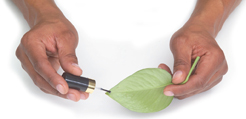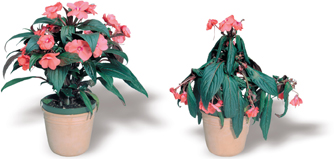Quick Lab
GUIDED INQUIRY
Examining Stomata

Obtain different kinds of leaves from your teacher.
Spread a thick coating of clear nail polish on the underside of each leaf.
Wait about 10 minutes for the polish to dry completely.
Attach a strip of clear tape to the polish and gently peel off the tape, lifting the dried polish.
Tape the polish to a clean microscope slide and examine under a 400× lens.
For each leaf, move the microscope stage so you can count stomata from three distinct fields of view.

Calculate What is the average number of stomata per square cm for each leaf?

Graph Make a graph that compares these averages.
Form a Hypothesis What could account for differences in stoma density among plants? Write a hypothesis.
Analyze and Conclude
In general, stomata are open during the daytime, when photosynthesis is active, and closed at night, when open stomata would only lead to water loss. However, stomata may be closed even in bright sunlight under hot, dry conditions in which water conservation is a matter of life and death. Guard cells respond to conditions in the environment, such as wind and temperature, helping to maintain homeostasis within a leaf.
Transpiration and Wilting Osmotic pressure keeps a plant's leaves and stems rigid, or stiff. High transpiration rates can lead to wilting. Wilting results from the loss of water—and therefore pressure—in a plant's cells. Without this internal pressure to support them, the plant's cell walls bend inward, and the plant's leaves and stems wilt. When a leaf wilts, its stomata close. As a result, transpiration slows down significantly. Thus, wilting helps a plant to conserve water.

FIGURE 23–17 Wilting A plant may wilt when water is scarce.
 In Your Notebook Make a list of molecules that are exchanged through the stomata. Which ones primarily enter the leaf? Which ones primarily exit the leaf?
In Your Notebook Make a list of molecules that are exchanged through the stomata. Which ones primarily enter the leaf? Which ones primarily exit the leaf?
Table of Contents
- Formulas and Equations
- Applying Formulas and Equations
- Mean, Median, and Mode
- Estimation
- Using Measurements in Calculations
- Effects of Measurement Errors
- Accuracy
- Precision
- Comparing Accuracy and Precision
- Significant Figures
- Calculating With Significant Figures
- Scientific Notation
- Calculating With Scientific Notation
- Dimensional Analysis
- Applying Dimensional Analysis




